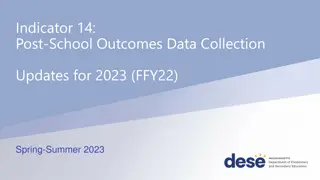
Compiler Design Basics: Lexical Analysis Strategies
Learn about lexical analysis in the context of COMP 3200, covering topics such as building a lexer, creating DFAs and NFAs, handling overlapping cases, and next steps in the process. Dive into implementing token types, constructing finite automata, converting NFAs to DFAs, minimizing DFAs, and utilizing various algorithms for efficient compiler design.
Uploaded on | 0 Views
Download Presentation

Please find below an Image/Link to download the presentation.
The content on the website is provided AS IS for your information and personal use only. It may not be sold, licensed, or shared on other websites without obtaining consent from the author. If you encounter any issues during the download, it is possible that the publisher has removed the file from their server.
You are allowed to download the files provided on this website for personal or commercial use, subject to the condition that they are used lawfully. All files are the property of their respective owners.
The content on the website is provided AS IS for your information and personal use only. It may not be sold, licensed, or shared on other websites without obtaining consent from the author.
E N D
Presentation Transcript
Lexical Analysis COMP 3200
ALERTS Homework #2 due Friday Reading Assignment #4 available In particular, Chapter 2 of the 'Basics of Compiler Design' by Mogensen Project #1 due Friday, Sept 24
Building a Lexer: There are options... Write a program by hand: ? ?? ?? ????????? (??? ???? ????? ?? ????????) See JavaScript example... Build a DFA for each token type: ??? ? ?? ???????????? ?? ????? ?? ???? ? ???? SLOW Build a single DFA that checks all token types at once: Sounds hard, but with the right tools its the best option
Building a Lexer: DFA Write regex's for each token type Construct an NFA for each regex Mark accepting states with names of tokens that they acept Combine NFAs into a single machine using -transitions from a new start state
Building a Lexer: NFA intermediate step
Building a Lexer: DFA Write regex's for each token type Construct an NFA for each regex Mark accepting states with names of tokens that they acept Combine NFAs into a single machine using -transitions from a new start state Convert this NFA into an equivalent DFA Minimize the DFA Ensure that accepting states are still marked with names of accepted tokens
Building a Lexer: DFA Final Step
Building a Lexer: DFA What if there are overlapping cases? Priority is specified in top-down fashion in the order in which the regexs are defined. Longest matching prefix is what is selected
Building a Lexer: Where to go from here? We need a collection of algorithms: Regular expression to NFA generator NFA to DFA converter DFA Minimization DFA Emulator (DFA data structures and algorithm) THEN: off-the-shelf tools...
Regex-2-NFA Recall that there are 6 parts to the regex definition (3 base & 3 recursive) a a + b b ab a b a a a* a
Regex-2-NFA Recall that there are 6 parts to the regex definition (3 base & 3 recursive) a + b: build an NFA for each part, then add a new start state with an -transition to each of their start states ab: build an NFA for each part, then add an -transition from all the accepting states of the first to the start state of the second; the accept states of the first become non-accepting a*: build an NFA for the part, then add -transitions from all its accepting states back to its start state; then add a new accepting start state with an -transition to the old start state
Regex-2-NFA Examples (a+b)* aba + bb * ab* ab + (a+b)*aba(a+b)* (a + )(bb)* (bab)*a






















